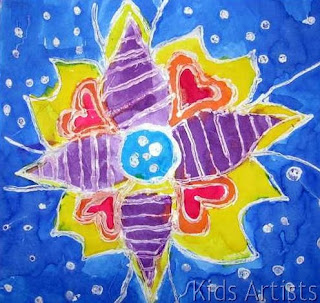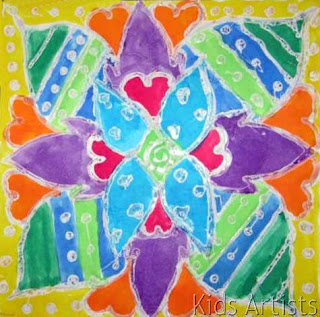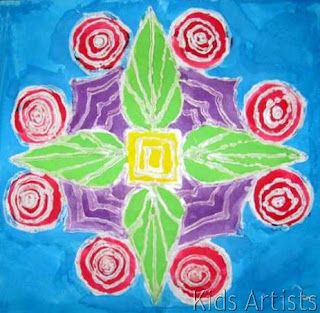Made by Malou, 11 years old
You need:
- Liquorice Allsorts
- grey construction paper A3 size
- oil pastels
Liquorice allsorts consist of a variety of liquorice candies sold as a mixture. These confections are made of liquorice, sugar, coconut, aniseed jelly, fruit flavourings, and gelatine. They were first produced in Sheffield, England. Allsorts are produced by many companies around the world today, and are most popular in Britain, continental Europe, and North America. The Dutch name for liquorice allsorts is "Engelse drop", and in Finland they are called "Englannin lakritsi/laku"; both literally translate as "English liquorice."
Make groups of two children. Buy some bags of liquorice allsorts (I used one bag for six students). Divide the liquorice so so that each group can make a different composition of them.
Give the children a sheet of grey construction paper. I chose grey, because the oil pastels alle kinderen een grijs tekenvel. Grey, because the oil pastel colours will be slightly less bright, and the white of the liquorice allsorts will be clearly visible. Ask children to make a composition of the liquorice; they may be stacked also.
On the gray sheet students draw the liquorice extra large. The liquorice must really be blown up! Don't use pencils, draw directly with the oil pastel. The whole sheet have to be filled with liquorice allsorts, with parts of them on the edges of the sheet. Colour everything and look carefully to the light: which part of the liquorice has to be dark, and which part has to be coloured lighter? Vary in dark and light colours by pressing harder or softer.
And of course you may eat the liquorice after finishing your artwork!
Made by students of 10-11 years old
.jpg)
.jpg)
.jpg)
+(2).jpg)
+(3).jpg)
.jpg)

.jpg)
.jpg)
.jpg)
.jpg)
.jpg)
.jpg)
+(2).jpg)
.jpg)
+(2).jpg)
.jpg)
.jpg)
.jpg)
.jpg)
.jpg)


+(2).jpg)
.jpg)
.jpg)
.jpg)
.jpg)
.jpg)
.jpg)



.jpg)
.jpg)
.jpg)
.jpg)
.jpg)
.jpg)
.jpg)
.jpg)
.jpg)
.jpg)
.jpg)
.jpg)



.jpg)
.jpg)
.jpg)
